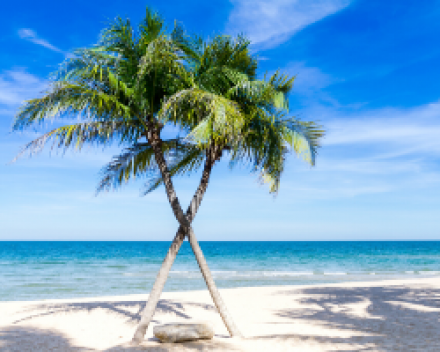Exploring Son Doong Cave, the largest cave in the world - Handspan Travel Indochina
2Son Doong Cave, nested at the heart of the Phong Nha - Ke Bang National Park, is the world’s largest cave. With a magnificent stalactite system and unique primeval rainforest inside the cave, the cave will undoubtedly offer an unparalleled adventure for explorers and nature enthusiasts alike. Let’s explore Son Doong Cave with Handspan Travel Indochina!
Through this blog post, you will find the following pieces of information.
- General information about the Son Doong Cave
- Weather and climate in Son Doong cave
- Geology, geomorphology, and ecosystem of Son Doong Cave
- Unique features of Son Doong Cave
- Son Doong Cave tour itinerary
- Difficulty level of the Son Doong Cave tour
- Physical requirements to join the Son Doong Cave exploration tour
General information about the Son Doong Cave
Son Doong Cave is the largest natural cave in the world. It is located in Tan Trach Commune, Bo Trach District, Quang Binh Province. The cave is a part of the Phong Nha - Ke Bang Cave complex. It is connected to more than 150 other caves in Vietnam near the border with Laos. Son Doong Cave was first discovered in 1991 by Ho Khanh, a local resident. In 2009, the British Caving Royal Association (BCRA) expedition came to this place to explore. The name of the cave is a combination of two words. Son means mountain in Vietnamese while Doong is the name of the valley where the Rao Thuong stream flows through. Son Doong overall means the cave in the limestone mountain with an underground river flowing through.
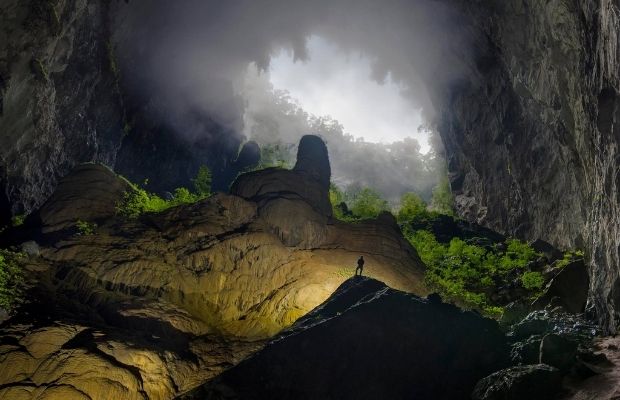
Exploring Son Doong Cave
The cave’s length is nearly nine kilometers. The highest part of the cave arch is 200 meters high and 150 meters wide. Son Doong Cave has become the first and only place in the world to have a record set by three world record organizations until now. They are the Guinness World Records (headquarters in England), the World Records Association (headquarters in Hong Kong), and the World Records Union (headquarters in the US and India). The cost to explore Son Doong Cave is about 72 million VND.
Weather and climate in Son Doong cave
The Son Doong - Phong Nha area has four seasons a year like many Northern provinces of Vietnam. They are spring, summer, autumn, and winter. For weather reasons and to ensure safety for tourists, especially in the rainy season, the Son Doong tour only operates from January to the end of August every year. From January to March, the weather will have a combination of hot and cold temperatures. If you visit Son Doong Cave at this time, you will have the opportunity to admire the bright golden rays of sunlight shining deep inside, illuminating the entire cave.
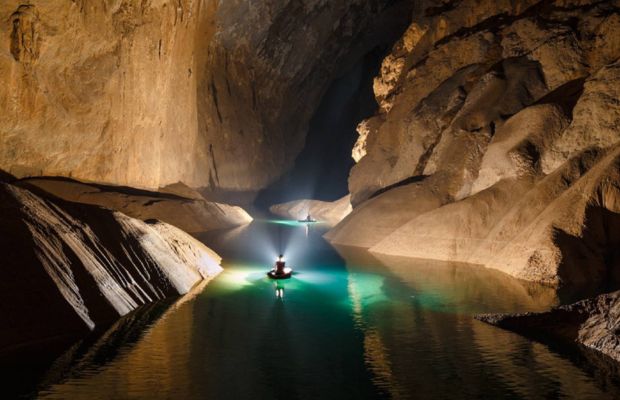
Son Doong Cave
April and May is the time when you can see wildflowers blooming and clouds and fog inside the cave. At this time, the weather is warm and not too hot. From June to August, the weather in Phong Nha is getting hotter. However, the temperature inside the Son Doong Cave just ranges from 22 to 25 degrees Celsius, so you won’t feel hot. Visiting the cave these months, you can comfortably swim in the streams and underground lakes inside the cave.
Geology, geomorphology, and ecosystem of Son Doong Cave
Located deeply in the core area of Phong Nha - Ke Bang National Park, Son Doong Cave has great value in terms of size and special geological and geomorphological characteristics. Due to the sinkholes, the light can shine into the cave, which creates flavor conditions for trees, moss, algae, etc. to grow. Let’s explore Son Doong Cave’s geology, geomorphology, and ecosystem.
Geology and geomorphology of the Son Doong Cave
Son Doong Cave is located in the oldest and largest limestone massif in Southeast Asia, formed 400 million years ago. Limestone blocks are formed slowly from two sources: chemical and biological. The biological limestone is formed mainly from the skeletons and shells of organisms.
Shells, snails, foraminifera, and most types of coral skeletons can be the original materials to create biological limestone. After the movements of the earth's crust, the sediment layers rose up to form today's limestone mountains.
The cave was formed on a fault in the Truong Son range merged with the water of the Rao Thuong River and Hang Khe Ry, the longest water cave in Asia. The process of corrosion over millions of years has created a giant tunnel beneath the rock layer. Cracks in the cave ceiling eroded and subsided, forming large sinkholes. Inside the cave, there is an underground river that flows through every year during the rainy season. Large amounts of water and strong currents continue to erode and expand the Son Doong Cave.
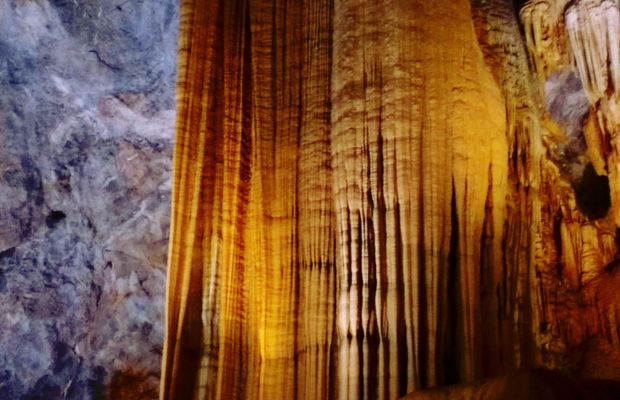
Stalagmites inside Son Doong Cave
The structure of Son Doong Cave includes 3 sections. The first section from the cave entrance to Sinkhole 1 is still in an active passage, along with the fixed flow of the underground river. The second and third sections of the cave are the fossil corridors and the Passchendaele corridor, where no rivers flow. This creates conditions for the strong and diverse development of stalactite formations in these corridors.
One of the special stalactite structures discovered in Son Doong Cave is the Phytokarst structure. It is the decomposition of limestone by biological activities. They are formed by blue-green algae growing on limestone or calcium rocks.
The ecosystem of Son Doong Cave
Scientists have found more than 200 species of plants living in the Son Doong Cave. They are herbs, algae, vines clinging to cliffs, shrubs, small trees, large trees, etc. There is a large underground stream and deep lakes inside the cave, which are home to many species of fish. They can adapt to the eternal dark environment inside the cave. Currently, biological researchers have discovered more than 7 new species in Son Doong Cave. They including some types of fish, weevils, millipedes, spiders, and scorpions. They have the common characteristics of having no eyes and transparent bodies.
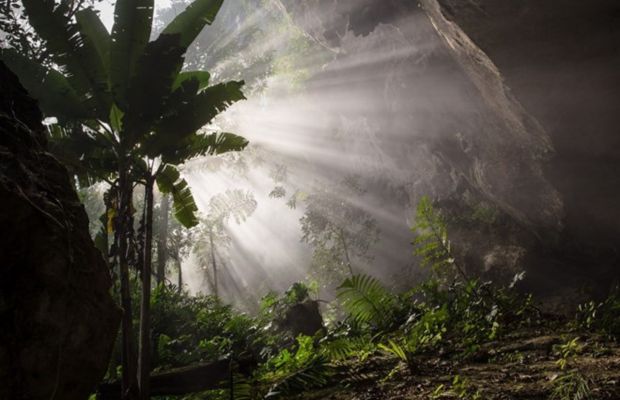
Primeval forest inside Son Doong Cave
Son Doong Cave is the first and only cave on earth that owns a primeval forest. Thanks to two sinkholes, plants can grow and multiply in caves. The first sinkhole (Sinkhole 1) has steep terrain, mostly rocky, with little soil. Besides, the mouth of this sinkhole is narrow; therefore, this area only has growing shrubs such as ferns or small trees, moss, and algae. Meanwhile, there is a large primeval forest with trees over 40 meters high inside the second sinkhole (the Garden of Edam).
Unique Features of Son Doong Cave
Son Doong Cave is unique not only because of its spacious cave bed but also due to its stalactites of enormous size and the primeval forest growing inside the cave as mentioned above. Let’s explore unique things only found inside Son Doong Cave with us!
Hope and Vision Cave branch
Hope and Vision cave branch is a straight and large cave section, about 1.5km long from the stream crossing point inside Son Doong cave to Sinkhole 1. From the beginning of the cave branch, you can see the rays of light coming from sinkhole 1 at a distance of 1.5 kilometers. Inside Hope and Vision, there is an underground river flowing at a depth of 40 meters from the explorer's path. Besides, there is a stalagmite named "Hand of Dog" and a giant stalactite block that is considered the tallest stalactite column in the world, with a height of 80 meters.
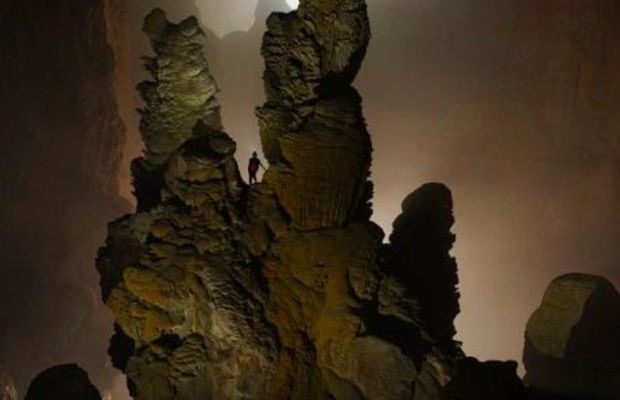
Hope and Vision stalagmite
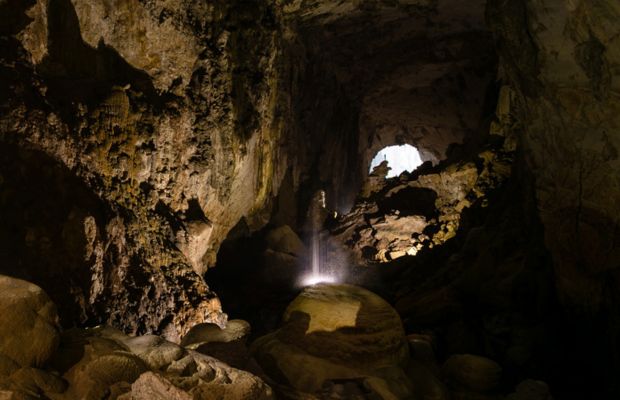
Hand of Dog Stalagmite
Underground river
Inside the world's largest cave, there is an underground river flowing from Hang En and Hang Khe Ry (a cave with a water source from Laos). The underground river in Son Doong has transformed the environment and ecosystem inside the cave to become more unique and strange. The stream flows through many rapids, creating many layers of mist inside the cave or clouds of steam floating in the large cave dome.
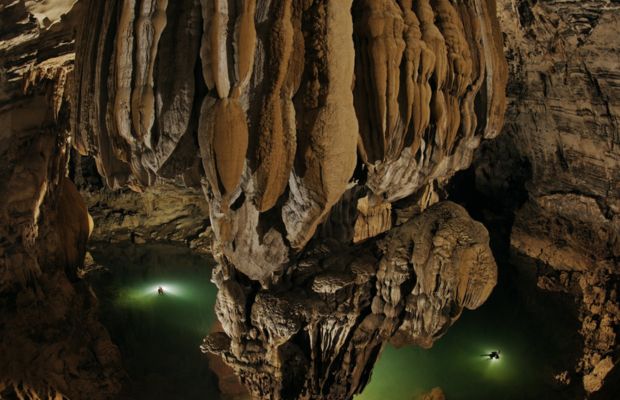
Underground river inside Son Doong Cave
Fossil passage
The fossil passage is located next to the underground river at a depth of 40 meters under the first sinkhole. It is the place where limestone rocks still imprint fossilized snails, clams, fish skeletons, and corals from many hundreds of millions of years ago. This is also an area with an underground lake with temperatures ranging from 16 to 17 degrees Celsius. You can wear life jackets and use headlamps to swim and relax after a strenuous day of trekking from En Cave.
The first sinkhole: Watch Out For Dinosaur
The first sinkhole is the area where the cave dome collapsed, creating a skylight area leading to the outside. This is also the location where the underground river disappears. Coming to the first sinkholes, you can see a large stalactite block called “Wedding Cake,” and a cave called “Rat Run.” From here, you will admire a panoramic view of the sinkholes and the rays of sunlight passing through the cave.
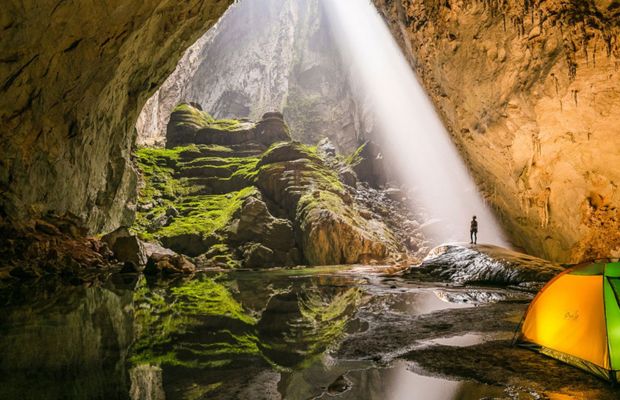
The first sinkhole inside Son Doong Cave
The second sinkhole: Garden of Edam
Sinkhole 2 is located about 1 km from Sinkhole 1. There is a primeval forest 200m deep inside the cave and below the limestone mountains here. The camp in this area is the place that receives the most light from outside.
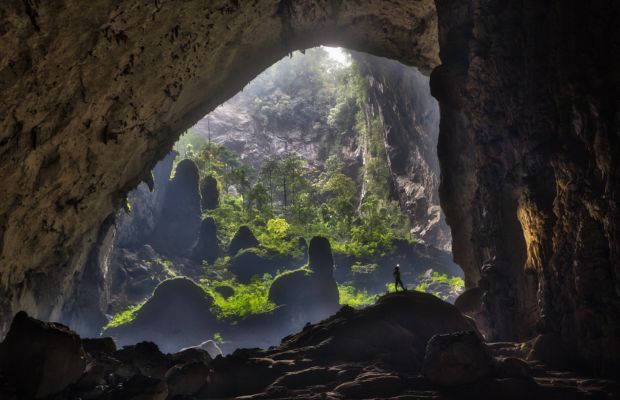
The second sinkhole inside Son Doong Cave
Cave pearls
Cave pearls are calcium stones formed from drops of calcium-carrying water from the cave ceiling dripping onto the calcium seams below the cave floor. They come in many different shapes and sizes.
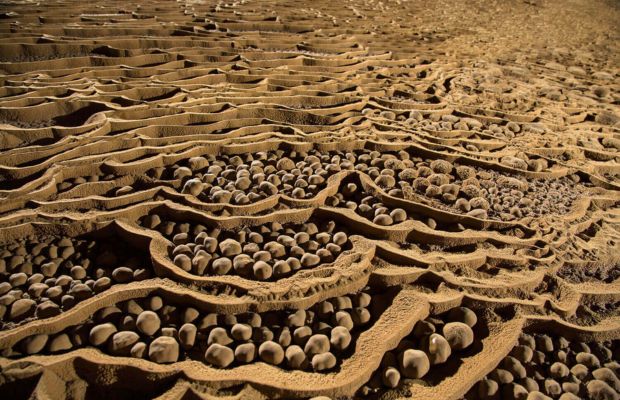
Cave Pearls inside Son Doong Cave
Passchendaele corridor
Passchendaele corridor is the lake under the Great Wall of Vietnam, with a length of 600 meters. During the months when the lake is full of water, you can use rafts and boats to move through this Passchendaele area.
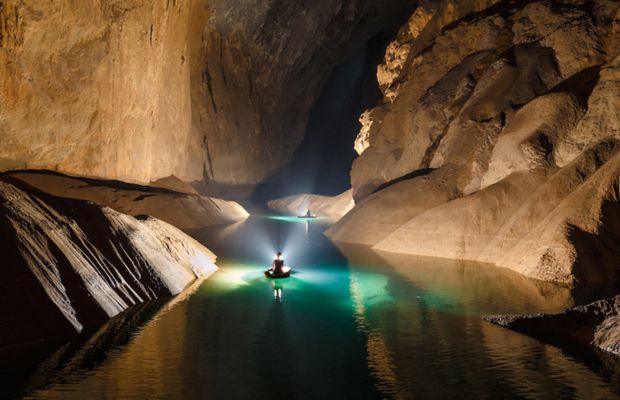
Passchendaele corridor inside Son Doong Cave
The Great Wall of Vietnam
The Great Wall of Vietnam is the highest stalactite wall at the end of Son Doong, with the highest ceiling at about 200 meters. From here, you will go another 500 meters to exit the cave and walk along the rocky slopes to reach Ho Chi Minh Road.
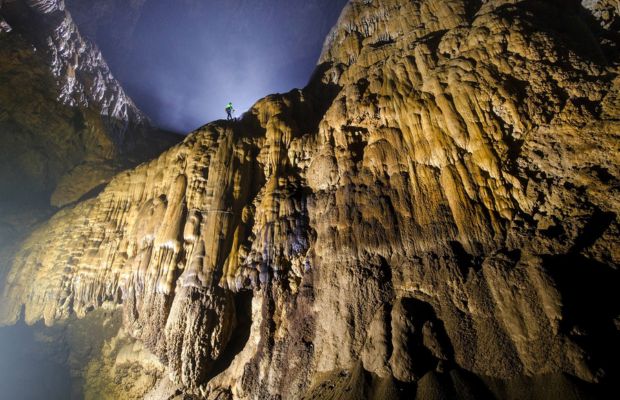
The Great Wall of Vietnam inside Son Doong Cave
Son Doong Cave tour itinerary
Among the cave exploration tours in Phong Nha - Ke Bang, the Son Doong Cave tour is the most challenging and has the longest duration. The tour will go through primeval forests with up and down slopes many times, with altitude differences ranging from 150 meters to 800 meters. Taking this tour, you will have to cross the stream more than 50 times during the journey. The width of the stream is from 10 to 50 meters and knee-deep water. The terrain inside the cave is rough. There are parts where you have to climb over many large rocks, use ladders, and cross flat sandy beaches. The Son Doong Cave expedition tour itinerary may change due to weather conditions. The path can be quite muddy and slippery when it rains. Normally the tour itinerary will include six days as follows.
First day: Phong Nha
On this day, the tour guide will pick you up from the Dong Hoi station/ airport to Phong Nha. You will meet safety experts, tour guides, and other members of the group and receive safety information and equipment for the journey. You will have to join this safety briefing day before starting your Son Doong Cave exploration trip. After the dissemination of safety regulations, you have to carefully read and sign a release form to participate in the tour.
Second day: Doong Village - En Cave
The second day of the trip will give you a chance to trek through the forest and wade through many rivers and streams. You can visit the Doong Village and learn about the life of the Bru-Van Kieu ethnic minority living here. After that, you will continue trekking to reach the En Cave. Entering the cave entrance with an underground river flowing through and continuing climbing through large stacked rocks, you will get to the camping site into the cave.
Third day: Campsite Sinkhole 1
Going deeper into the En Cave and taking the back entrance, you will reach the Son Doong Cave entrance. As soon as you step down inside the cave, you can feel the cold air accompanied by mist blowing. With the help of large flashlights from staff and porters, you will witness the enormous size of Son Doong Cave. Continuing to cross the underground river and climbing over large rocky slopes and dunes, you will reach the Hand of Dog stalagmite area and the campsite.
Fourth day: Campsite Sinkhole 2
On this day, you can visit the first sinkhole: Watch Out For Dinosaur before exploring the Garden of Edam. After exploring this special forest, you will continue walking into the dark cave to learn about the unique creatures living in the cave.
The fifth day: The Great Wall of Vietnam - Cave Exit - Chay Lap Farmstay
After breakfast, you will wear safety belts and are instructed to use safety equipment to prepare to conquer the Great Wall of Vietnam. This is one of the most attractive Son Doong Cave exploration activities. This is an adventurous challenge, but as long as you have good physical strength, you can completely conquer it thanks to the support of the safety team.
The last day: Chay Lap Farmstay - Dong Hoi
On the last day of your trip, you are free to explore Phong Nha. You can visit Chay Lap Riverside, Blue Diamond Camp, Thien Duong Cave, Nuoc Mooc Stream, etc., before transferring to the station/ airport.
Difficulty level of the Son Doong Cave tour
As mentioned, the Son Doong Cave exploration tour is classified as the most difficult of the tours in Phong Nha. The difficulty of the tour is designed based on the tourists’ overall fitness, not on the fitness of runners or people who practice high-intensity sports. There are many long-distance trekking sections, crossing rivers and streams, and overcoming rocky terrain. All of the activities during the tour require participants to use specialized safety technical equipment. Detailed activities are as follows.
- Crossing 25 kilometers of mountainous forest road, rocky terrain with altitude difference up to 800 meters.
- 50 times rivers and streams crossing both inside and outside the cave (about knee-deep or more depending on weather conditions).
- Three nights camping inside the cave
- 8-kilometer exploring the cave, including climbing caves with safety ropes, walking on large rocks, and moving on uneven terrain inside the cave.
- 90 meters climbing down to the cave entrance with a slope up to 45 degrees
- 90 meters climbing up to the Great Wall of Vietnam, of which 18 meters is climbed by ladder and 72 meters is climbed at a 45-degree slope
Physical requirements to join the Son Doong Cave exploration tour
Before joining the Son Doong Cave exploration tour, you will have to meet physical requirements. The basic physical conditions to participate in the tour include experience and physical training.
Trekking experience requirements
If you want to explore the Son Doong Cave, you must join at least one overnight trekking trip and one to two-day treks within the last 12 months. These trekking tours are required to have a route through the forest/ mountain/ rock/ steep terrain. You have to travel at least 8 kilometers a day, with an altitude difference of 300 meters.
Physical training requirements
You are required to play one of the strong sports like soccer, cycling, skiing,etc. Besides, you must exercise regularly with outdoor activities like walking/jogging (3-4 sessions/week, 4-5 kilometers/ session). You have to ensure you have enough physical strength to run 5 kilometers continuously within 50 minutes and climb 5 floors continuously without difficulty breathing or dizziness.
In conclusion, you have just known detailed information about the Son Doong Cave. Exploring the cave is an adventure filled with unique and unforgettable experiences. From trekking through the jungle and descending into the cave’s massive chambers to camping, swimming, and discovering ancient fossils, each activity offers a deeper connection with one of the world’s most extraordinary natural wonders. If you want to join the Son Doong Cave tour exploration, don’t hesitate to contact us.
__logo.png)
__hanoi-water-puppets.jpg)
__angkor-wat-blue-reflections.jpg)
__vientiane-buddha-park-monks.jpg)
__bagan-dhammayazika-dusk.jpg)
